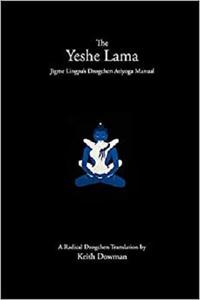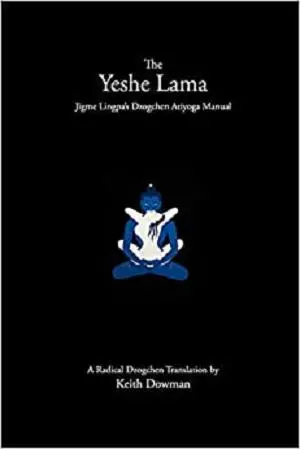The Yeshe Lama: Jigme Lingpa's Dzogchen Atiyoga Manual by Keith Dowman
English | November 22, 2014 | ISBN: 1502716224 | 268 pages | AZW3 | 0.402 MB
English | November 22, 2014 | ISBN: 1502716224 | 268 pages | AZW3 | 0.402 MB
Here is the great Yeshe Lama, the most renowned, comprehensive and the most efficacious of the Dzogchen manuals. It is a sourcebook for Dzogchen Breakthrough/Leapover precepts. Certainly, the Yeshe Lama lives up to its reputation. It is still the crown jewel of the latter-day Dzogchen lineages. It is at the apex of the Longchen Nyingtik corpus of literature, presenting the essential Dzogchen yogas in pith instruction. The Longchen Nyingtik is based firmly in Longchen Rabjampa’s vision, a massive, vast and profound Dzogchen vision written down as the Seven Treasuries, which in turn were based intimately upon the tantras of the Nyingma Gyubum, the treasure house of Dzogchen. The translation was made for the benefit of students who have received transmission and oral instructions from a teacher and need clarification and elucidation from an authoritative literary source. It is meant for yogins and yoginis, adepts and practitioners. It may not be finally authoritative, but grounded in the wisdom of the old Dzogchen lamas who were wise before they came out of Tibet, as the fruit of a lifetime’s listening, studying and contemplation it may be of some use to people who are committed to the Dzogchen yogi ethos. The urban yogis who have no connection with the traditional teaching may also appreciate access to its precepts. Most significantly, in my mind, this translation stresses the nondual aspect of Dzogchen, the radical aspect that is overlooked by conventional Buddhist Vajrayanists.The translation attempts, wherever possible, to clarify instruction, resolve ambiguities, and turn abstruse Tibetan nuance and allusion into comprehensible English prose. Sometimes that is not possible because of an absence of English equivalents of Tibetan terms or metaphors, sometimes because of the density or obscurity of the Tibetan meaning, sometimes because an arbitrary meaning has been lost in the recent attenuation of the tradition. Certainly, this translation does not purport to reproduce the high literary quality and form of Jigme Lingpa’s Tibetan prose – which is inimitable. Nor is it a literal translation where every word is accounted for and every instance of a particular word translated by the same English equivalent. Rigzin Jigme Lingpa, the eighteenth century mystic-scholar who composed the Longchen Nyingthig was an incarnation of Longchenpa in the most significant sense of the expression and his Longchen Nyingtik became the seed, root and branch of a Dzogchen revival that reverberates around the entire world at the beginning of the twenty-first century.ContentsIntroduction i-lvThe Yeshe Lama Prologue 1Part OneChapter One: Basic Training 9Chapter Two: Fruition in Breakthrough Nonmeditation 27Chapter Three: Fruition in Leapover Methods 41Part TwoChapter Four: The Four Bardos 101Part ThreeChapter Five: The Fields of Natural Emanation 147Appendixes1. Structure of the Tibetan Text 1532. Texts Cited 1573. The Twelve Vajra Laughs 1624. The Vase-Body 1645. The Ground, Path and Fruit 1676. List of Similes 169Glossary 177English – Tibetan Concordance 188Sanskrit-English Concordance 191Bibliography 194Index 197



